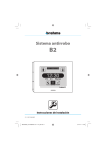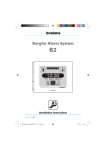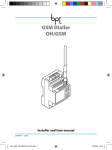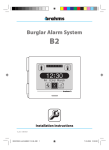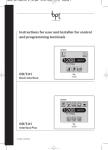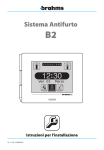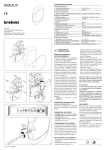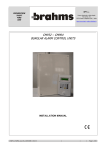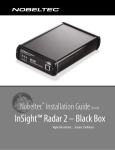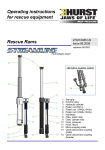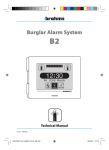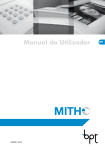Download GSM communicator BXGM0001
Transcript
GSM communicator BXGM0001 Installer and User manual 05-02-10/24852600 BXGM0001 24852600 05-02-10_EN.indd 1 05/02/10 10:38 Use and Applications The modules consists of a telephone communicator on a GSM network for BRAHMS model burglar alarms B2UC0002 The device lets you remotely control the main functions (activation, deactivation, sectioning, etc.) of the BRAHMS burglar alarm where it is installed by sending SMS messages. The communicator, when properly programmed, is capable of sending voice or SMS messages (or both) which inform the user of events that have occurred that concern the system. The SMS messages that are sent to the GSM module can be customised, allowing them to be memorised and subsequently transmitted more easily, or written in a different language from the default one (Italian). The customisation can be carried out using the SMS messages described in the column highlighted in the table (customised SMS sent by the User), where in place of the word “Comment”, a customised text can be added. The device is also equipped with a normally open relay contact which can be used to activate TH Bpt heat regulators designed for remote control or any other device set up for this purpose, controlled through the opening or closing of a contact. By adding the optional card BXGMOH01 you can use the module in “mixed” BRAHMS burglar alarm systems in conjunction with BPT HOASIS home automation systems. m ATTENTION • The BXGM0001 dialler is compatible with B2UC0002 equipped with terminals of version 1.0 or greater. The version of the terminal can be obtained from the packaging label, from the label on the back of the terminal, or it can be read directly on the screen by pressing the button . 2 BXGM0001 24852600 05-02-10_EN.indd 2 05/02/10 10:38 Index Use and Applications . . . . . . . . . . . . . . . . . Page 2 Safety warnings . . . . . . . . . . . . . . . . . . . . . . . Page 4 Installer instructions User instructions General technical characteristics . . . . Page 6 Contents of package . . . . . . . . . . . . . . . . . . . . . . . . . 6 Functions that can be performed by SMS . . . . . . . . . . . . . . . . . . . . . . . . . . . . . . . . . Page 22 Installation of the SIM card and the optional card BXGMOH01 . . . . . . . . Page 7 Messages to user by voice and SMS for B2 control units . . . . . . . . . . . . . . . . . . . Page 24 Positioning of the device . . . . . . . . . . . . . Page Assembly of the antenna . . . . . . . . . . . . . . . . . . . . . Assembly in the plastic container B2CTPL01 on BRAHMS B2 control unit. . . . . . . . Assembly in the metallic container B2CTME01 on BRAHMS B2 control unit . . . . . . . Reminder of the communicator settings . . . . . . . . . . . . . . . . . . . . . . . . . . . . . . . Page 25 8 8 8 8 Terminal boards and connectors . . . . . Page 9 Commissioning . . . . . . . . . . . . . . . . . . . . . . . Page 10 Connection diagrams . . . . . . . . . . . . . . . . . Page 11 Programming of the communicator through SMS . . . . . . . . . . . . . . . . . . . . . . . . . . Page 14 Create an address book . . . . . . . . . . . . . . . . . . . . . . 14 Add a telephone number to the address book. . . 15 Modify a telephone number in the address book. . . . . . . . . . . . . . . . . . . . . . . . . . . . . . . . . . 15 Deletion of a telephone number in the address book. . . . . . . . . . . . . . . . . . . . . . . . . . . . . . . . . . . 15 Use of special telephone numbers in the communicator. . . . . . . . . . . . . . . . . . . . . . . . . 15 Find out your remaining SIM credit . . . . . . . . . . . 15 Deactivate SMS reception by a number in the address book . . . . . . . . . . . . . . . 16 Programming of the General Preferences of the communicator through SMS . . . . . Page 17 Communications attempts. . . . . . . . . . . . . . . . . . . 17 Cyclical sequence. . . . . . . . . . . . . . . . . . . . . . . . . . . . . 17 End cycle of calls . . . . . . . . . . . . . . . . . . . . . . . . . . . . . 17 Dialling pause. . . . . . . . . . . . . . . . . . . . . . . . . . . . . . . . 17 Default parameters on module. . . . . . . . . . . . . . . 18 3 BXGM0001 24852600 05-02-10_EN.indd 3 05/02/10 10:38 Safety Warnings m ATTENTION • After removing the packaging, check the condition of the unit. • The packaging items (plastic bags, expanded polystyrene, etc.) must not be handled by children as they may be dangerous. • Carefully read the instructions before starting installation. Perform work as specified by the manufacturer. • Before connecting the equipment, make sure that the rating plate data corresponds to that of the distribution network. • An omnipolar switch, with contacts separated by at least 3mm, must be installed upstream on the equipment, on the electric system of the building. • The manufacturer declines all liability for any damage as a result of improper, incorrect or unreasonable use. • Before performing any cleaning or maintenance operation, disconnect the equipment from the power supply network by opening the system switch. • In case of failure and/or malfunction of the device, detach it from the power supply and do not tamper with it. • Use original spare parts. • Installation, programming, commissioning and maintenance of the product must only be performed by qualified technicians who have been properly trained in compliance with current standards including compliance with accident prevention. • Operate in sufficiently lighted areas that are conducive to health and use tools, utensils and equipment that are in good working order. • Upon completion of installation, always check for correct operation of the unit and the system as a whole. • Do not install the device outdoors or in areas where it is exposed to seepage or splashes of water. • Handle the device with care. It contains electronic parts that are fragile and sensitive to humidity. • The electronic cards can be seriously damaged by discharges of static electricity. If they are to be handled, wear suitable clothing and anti-static footwear, or at least, ensure static electricity has been discharged by touching with the fingertip a metallic surface connected to the earth system (e.g. the chassis of a household appliance). • Weld the joints between wires to prevent false alarms caused by oxidation of the wires. • The electrical system must comply with current standards in the country of installation. • Failure to comply with the above instructions may compromise the unit’s safety. • The installer must make sure that the information for the user, where applicable, is present on the devices. • Dispose of the unit in accordance with current standards. 4 BXGM0001 24852600 05-02-10_EN.indd 4 05/02/10 10:38 Installer instructions BXGM0001 24852600 05-02-10_EN.indd 5 05/02/10 10:38 Package contents · GSM module · Instructions · DIN rail · Antenna 45 The communicator BXGM0001 is contained in a DIN70 module which can be fastened in the spaces provided in the containers of the BRAHMS burglar alarm control units or in any electrical enclosure provided with DIN rails. 106 General technical characteristics 43,5 70 57 145 7,5 70 64,5 Technical specifications of the communicator Weight 160 grams Container material PPOX (Polypropylene oxide) Degree of protection IP 30 Power supply 15 V AC or from the 12 V DC supply line Standby consumption 310 mA with 15 V AC –– 110 mA with 12 V DC Communication consumption 360 mA with 15 V AC –– 180 mA with 12 V DC GSM module type Modem GSM/GPRS Dual Band 900/1800 MHz Operating temperature from +0 °C to +40 °C Storage temperature -10 °C to +60 °C. Relative Humidity < 90% without condensation 6 BXGM0001 24852600 05-02-10_EN.indd 6 05/02/10 10:38 Installation of the SIM Card and the optional card BXGMOH01 In order to operate, the device must be equipped with a SIM card, not included in the package, to be inserted in the appropriate housing. The device can work in conjunction with the Hoasis Bpt home automation system by adding the interface module (optional)BXGMOH01 to be assembled as shown in the figure. To do this, unscrew the two fastening screws and remove the dialler cover. Do this making sure that you do pull out the antenna wire. SIM card not included SIM card housing Optional module BXGMOH01 for interfacing with Hoasis+ BPT home automation system m ATTENTION • If the SIM card is new, prior to inserting it into the communicator, make a call by inserting it into a mobile phone thus allowing the mobile telephone operator to register the card. • The device requires that the SIM cards are activated only vocally and by SMS (No SIM Data!) • Before carrying out the programming operation, deactivate the SIM card PIN code. c ATTENTION! The electronic cards can be seriously damaged by discharges of static electricity. If they are to be handled, wear suitable clothing and anti-static footwear, or at least, ensure static electricity has been discharged by touching with the fingertip a metallic surface connected to the earth system (e.g. the chassis of a household appliance). 7 BXGM0001 24852600 05-02-10_EN.indd 7 05/02/10 10:38 Positioning of the device Assembly of the antenna. On the shell of the module, there is a seat for the insertion of the antenna included in the package. The antenna provided is swivel type so that it can be placed in any non-metallic container. If the module is installed inside a DIN box, move the seat of the antenna into the appropriate additional hole on the shell, thus allowing its correct closure. Fig.1 Assembly in the plastic container B2CTPL01 on BRAHMS B2 control unit Assemble the DIN rail provided on the bottom of the container, screwing it into the holes and fasten the module (fig.1). Assembly in the metallic container B2CTME01 on BRAHMS B2 control unit Assemble the DIN rail provided on the bottom of the container, screwing it into the holes and fasten the module (fig.2). Fig.2 m ATTENTION If the module is installed inside metal containers, use the optional antenna model BXANGM01 by placing it outside the container as shown in figure 2. Fig.3 8 BXGM0001 24852600 05-02-10_EN.indd 8 05/02/10 10:38 Terminal boards and connections RS 232 connector to interface the module with a PC Optional auxiliary battery connector Green LED: Voltage present CN1 M2 Yellow LED GSM transmission/reception in progress CN4 DL1 3 2 Red LED transmission/reception on line BUS B2 in progress Connection for antenna SIM Card SIM Card housing connector for assembly of card Hoasis BPT Jumper SW1 TAMPER disabled CN5 B2 C NO TAMPER TMP LCK DFT BTL LA M1 BUS LA Terminals BUS - LA BUS - B2 M1 C, NO TAMP BUS B2 C N0 TAMP Jumper SW4 boot loader Jumper SW3 default reset Meaning Terminal board for Bpt BUS Hoasis connection Terminal for connection to BUS B2 BRAHMS Relay contact 12V 1A (normally open) Terminal board for TAMPER contact connection Terminal board for earth connection M2 SW1 SW2 SW3 SW4 SW1 SW2 SW3 SW4 Jumper SW2 address book protection TMP LCK DFT BTL Terminal board for connection to power supply from power supplier When the jumper is connected the tamper contact is disconnected When the jumper is disconnected the address book cannot be modified via SMS By powering the module without jumper the default configuration is reset Boot-loader (jumper reserved for the Technical Service not to be removed) 9 BXGM0001 24852600 05-02-10_EN.indd 9 05/02/10 10:38 Commissioning m ATTENTION Before installing the module it is important to verify that there is an adequate radio receiving signal from the device in the area where the device needs to be installed. To do this, simply insert the SIM in a mobile phone and check reception. If reception is poor the device will have to be installed in another location with a better signal. Please be informed that the company Brahms S.r.l. declines all liability in the event of: • failed transmission, failed reception, delayed transmission or delayed reception of SMS messages by the communicator, when these are due to the quality of the reception signal or to any other problem related to the mobile telephone operator’s activities. • charging cost on the communicator remaining SIM credit resulting from messages sent by the mobile telephone operator or from other services carried out by the mobile telephone operator. Once the module has been placed in the appropriate containers, as described in the previous pages, proceed as follows: • Ensure voltage has been removed to the system. • Connect the communicator to the system BUS by means of the terminal BUS B2. • Connect the terminals to the power supplier of the system B2 or to the terminals of the control unit (as shown on the diagrams of the following pages). • Now restore voltage to the system. • The lighting of the green LED indicates that the module is powered. • The yellow LED, will remain on for a few seconds, during which the GSM device will verify mobile reception. If after a few seconds the yellow LED switches off the operation was successful. If, on the contrary, the yellow LED remains on this may indicate that there are GSM communication problems, related to reception failure or SIM card registration (see the chapter “Sim Card Assembly”). Once the installation has been completed the yellow LED will flash only in case of data transmission/reception on the GSM network. m At this point of installation it is essential to “teach” the device, following the instructions for installation of the burglar alarm system to which the GSM module is connected. If the red LED flashes, it means that communication on the BUS line is active. 10 BXGM0001 24852600 05-02-10_EN.indd 10 05/02/10 10:38 Diagrams for connection to Brahms B2 systems BXGM0001 M1 NO C BUS LA TH/450 BUS B2 TH450 M2 A questo contatto possono essere connessi cronotermostati Bpt TH/450 - TH/350 - TH/125, o qualunque altro dispositivo controllabile da remoto mediante apertura/chiusura di un relè. B2AL0001 M2 B2SEAL02 24 V 30 V BUS 12 V BUS M1 + – + B2IPPA01 BAT – TAMPER BUS BB065 – + B2UC0002 BB065 BUS – + 230Vac Fig.4 11 BXGM0001 24852600 05-02-10_EN.indd 11 05/02/10 10:38 Connection of BXGM0001+ card BXGMOH01 in mixed system comprised of Hoasis+ BPT home automation - Brahms B2 burglar alarm OH/A.01 OH/RI M3 LA LA LA OH/MA BXGSM001 BUS LA LA M1 BUS B2 OH/T.01 M2 B2AL0001 B2SEAL02 M2 24 V BUS 30 V BUS M1 B2IPPA01 + 12 V – + BAT – TAMPER BUS BB065 B2UC0002 – + BUS BB065 – + 230Vac Fig. 5 m ATTENTION If the GSM module is installed in “mixed” systems of BRAHMS B2 and HOASIS BPT, is it necessary to install on the module BXGM0001 the card BXGMOH01 (optional) so that the module can interface with both systems. 12 BXGM0001 24852600 05-02-10_EN.indd 12 05/02/10 10:38 BXGM0001 connection to Bpt series TH programmable thermostats BB008 + – OH/GSM CN1 TH.... M1 TH450 NO C BUS LA 1 2 BUS B2 Programmable thermostats can be connected to this contact, such as Bpt TH/450 - TH/350 - TH/125, or any other device that can be remotely controlled via the opening/closing of a relay. M2 15 V 230 V TRANSFORMER Fig. 6 230Vac The device is equipped (terminals C, NO of terminal board M1) with a relay contact that can be used to activate any controllable device by opening or closing a contact. Specifically, with the message “-password-25 <Comment>” you can control impulse contact devices, such as the heat regulators of the series TH Bpt set up for remote control (TH/125 - TH/350 - TH/450). Function Customised SMS sent by the User -password-23 <Comment> -password-24 <Comment> Closing of the dialler auxiliary contact relay Opening of the dialler auxiliary contact relay Closing of the dialler auxiliary contact relay for 3 seconds -password-25 <Comment> for activation of Bpt programmable thermostats Relay status request -password-26 <Comment> Reply SMS to the User RELAY ON RELAY OFF RELAY TH ON RELAY ON RELAY OFF . Note: The “-password-25 <Comment>” command, sent to Bpt programmable thermostats, activates a specific programm. For more details refer to the programmable thermostats manuals. For instance, in order to close the auxiliary contact relay the following SMS can be customized and used: -password-23 <CLOSE RELAY> 13 BXGM0001 24852600 05-02-10_EN.indd 13 05/02/10 10:38 Programming of the communicator through SMS The BXGM0001 communicator allows remote control and signalling functions via the receipt and sending of SMS messages from and to the telephone numbers contained in the address book saved in the internal memory of the communicator itself. m If you are using the telephone communicator on BRAHMS B2 systems, all of the following settings can be programmed in a simple, intuitive way via the interface and the touch-screen of the B2UC0002 terminal without the aid of SMS (see the B2 instruction manual B2). m Important! • Before starting programming the address book via SMS make sure that the jumper SW2 (LCK) is connected . With the jumper disarmed, the address book can be programmed only from B2 control units via the interface and the touch-screen of the terminal B2UC0002. • The communicator, when purchased, can receive programming messages sent by any telephone number. It is therefore advisable, once the programming of the address book has been completed, to disconnect the jumper SW2. • It is important to enter the appropriate international dialling code before the numbers that are being saved in the address book (+39 for Italy). • The SMS messages that are sent to the GSM module can be customised, allowing them to be memorised and subsequently transmitted more easily, or written in a different language from the default one (Italian). The customisation can be carried out using the SMS messages described in the column highlighted in the table (customised SMS sent by the User), where in place of the word “Comment”, a customised text can be added. CREATE AN ADDRESS BOOK The address book can be easily created via SMS messages structured in such a way that they carry the information necessary for programming the module. The address book can contain up to10 telephone numbers. Every programming SMS can send up to 5 numbers to the address book. These SMS messages must have the following structure: SMS no.1 6 < COMMENT > . first number . second number . third number . fourth number . fifth number SMS no. 2 7 < COMMENT > . sixth number . seventh number . eighth number . ninth number . tenth number Example If the GSM communicator must send or receive messages to/from only two numbers, the address book programming message will have the following structure: 6 < COMMENT > . + 3 9 3 4 7 1 2 3 4 5 6 7 . + 3 9 3 3 3 3 4 5 6 7 8 9 14 BXGM0001 24852600 05-02-10_EN.indd 14 05/02/10 10:38 ADD A TELEPHONE NUMBER TO THE ADDRESS BOOK If a telephone number needs to be added to the address book proceed as follows: Example If the address book contains 5 numbers, in order to add a sixth number, send the following message to the communicator: 2 2 < COMMENT > ( 6 ) + 3 9 3 3 3 8 8 8 8 8 8 8 . This message overwrites a number in position 6 in the address book. MODIFY A TELEPHONE NUMBER IN THE ADDRESS BOOK If a telephone number in the address book needs to be modified proceed as follows: Example The message shown in the example allows to overwrite the number in position 2 of the address book with a new one that will have to be written after the text “22<COMMENT>(2)”. 2 2 < COMMENT > ( 2 ) + 3 9 3 3 3 5 5 5 5 5 5 5 . DELETION OF A TELEPHONE NUMBER IN THE ADDRESS BOOK If a telephone number in the address book needs to be deleted proceed as follows: Example The message shown in the example allows to delete the number in position 5 of the address book leaving the same position in the address book empty; the message has the following syntax: 2 2 < COMMENT > ( 5 ) _ . USE OF SPECIAL TELEPHONE NUMBERS IN THE COMMUNICATOR It is possible to allow the messages from a specific telephone number to be sent to the first number in the address book. This function can be used to allow the informational messages from the specific mobile telephone operator (for example information on the credit) to be sent to the first number in the address book; to do this it is necessary to know the number for “Center Services” of the specific mobile telephone operator. This number can be obtained by contacting Customer Service. The programming message will have the following syntax: 2 1 < COMMENT > . number for telephone operator service centre . In order to deactivate the function enter 2 1 < COMMENT > . 0 . FIND OUT YOUR REMAINING SIM CREDIT In order to find out the remaining credit of your SIM it is necessary to send an SMS specifically structured depending on your telephone operator preceded by the word “8<COMMENT>”or “9<COMMENT>”. Some operators, for example Telecom Italia Mobile, require a message consisting of text + number; in this case the message will have the following syntax: 8 < COMMENT > “ required message by call operator “ code number required by the call operator . 8 < CREDIT > “ PRE CRE SIN “ 4916 . 15 BXGM0001 24852600 05-02-10_EN.indd 15 05/02/10 10:38 Other Operators, Vodafone Italia for example, require a simple vocal call to be sent to a number required by the call operator. The message will have the following syntax: 9 < COMMENT > “ C A L L “ + code number required by the call operator . 9 < CREDIT > “ C A L L “ +404 . DEACTIVATE SMS RECEPTION BY A NUMBER IN THE ADDRESS BOOK The default settings allow an event to be reported to all users through an a voice message and an SMS. However it is possible to allow some numbers to receive only voice messages. Example If you wish to prevent the fifth number in the address book from receiving SMS, but rather only voice messages, the programming message will have the following syntax: 1 9 < COMMENT > ( 5 ) O F F . In order to reactivate SMS reception by the number the programming message will have the following syntax: 1 9 < COMMENT > ( 5 ) O N . . Note: In the Brahms B2 type control unit, by means of the B2UC0002 terminal it is possible to deactivate the voice message as well. . Note: • Brahms declines all liability in case of transmission of SMS by the mobile telephone operator that decrease the communicator’s remaining SIM credit . • On page 23, the User can take note of the main programmed parameters for his own benefit and as a written reminder in case of future work on the system. 16 BXGM0001 24852600 05-02-10_EN.indd 16 05/02/10 10:38 Programming of the General Preferences of the communicator through SMS m If you are using the telephone communicator on BRAHMS B2 systems, all of the following settings can be programmed in a simple, intuitive way via the interface and the touch-screen of the B2UC0002 terminal without the aid of SMS (see the B2 instruction manual B2). Also by means of correctly structured SMS messages, you can set the following preference: COMMUNICATIONS ATTEMPTS (abbreviated with “NT” in the programming SMS messages) “Communications Attempts” means the number of unanswered calls (from 1 to 20) after which the communicator dials the next number in the address book. Example If you want the communicator to attempt to call three times the first number in the address book before going to the next one, send an SMS to the communicator with the following structure: 2 0 < COMMENT > “ N T “ ( 3 ) CYCLICAL SEQUENCE (abbreviated with “SC” in the SMS programming messages) “Cyclical Sequence” means that, if there is an unanswered call, the communicator will not make any other attempts but will go on to call the next number in the address book. To cause this to happen, send an SMS to the communicator with the following structure: 2 0 < COMMENT > “ S C “ O N END CYCLE OF CALLS (abbreviated with “TC” in the SMS programming messages) With the default setting, when an event occurs, the communicator calls all of the numbers in the address book whether the telephone call is successful or not. In this case the programming message will have the following structure: 2 0 < COMMENT > “ T C “ O F F If you want to interrupt the cycle of telephone calls when a call is successful, the programming message will have the following structure: 2 0 < COMMENT > “ T C “ O N DIALLING PAUSE(abbreviated with “PC” in the SMS programming messages) “Dialling Pause” means the time that must pass (from 0 to 255 seconds) between one call and the next. Example If you want the communicator to try to call the next number after a pause of 40 seconds, send an SMS with the following structure: 2 0 < COMMENT > “ P C “ ( 4 0 ) 17 BXGM0001 24852600 05-02-10_EN.indd 17 05/02/10 10:38 Programming does not necessarily have to take place with an SMS for each parameter to be set. In fact, you can group all information to be sent to the communicator in a single SMS; which may have the following structure: Example 2 0 < COMMENT > “ N T “ ( 3 ) “ S C “ O N “ T C “ O N “ P C “ ( 4 0 ) DEFAULT PARAMETERS ON MODULE COMMUNICATIONS ATTEMPTS CYCLICAL SEQUENCE END SEQUENCE OF CALLS DIALLING PAUSE “NT” “SC” “TC” “PC” 3 ON OFF 60 seconds With the default settings, all numbers in the address book receive a voice message and/or SMS when any event occurs that concerns the control unit. STATES FAULTS ALARMS Event type Intrusion Alarm Silent alarm Help Alarm Panic Alarm Sabotage Alarm Technological Alarm Auxiliary Alarm Network Fault Battery fault Fault System On System Off System Partially On Alarms Reset 1 X X X X X X X X X X X X X X 2 X X X X X X X X X X X X X X Phone number called 3 4 5 6 7 8 9 10 X X X X X X X X X X X X X X X X X X X X X X X X X X X X X X X X X X X X X X X X X X X X X X X X X X X X X X X X X X X X X X X X X X X X X X X X X X X X X X X X X X X X X X X X X X X X X X X X X X X X X X X X X X X X X X X X SMS and/or voice SMS and Voice SMS and Voice SMS and Voice SMS and Voice SMS and Voice SMS and Voice SMS and Voice SMS and Voice SMS and Voice SMS and Voice SMS and Voice SMS and Voice SMS and Voice SMS and Voice 18 BXGM0001 24852600 05-02-10_EN.indd 18 05/02/10 10:38 Function Customised SMS sent by the User Examples of customized SMS CREATE AN ADDRESS BOOK (first 5 numbers) 6<COMMENT>.first number. second number.third number. fourth number.fifth number 6<CREATE ADDRESS BOOK>. +393471234567. +393333456789 CREATE AN ADDRESS BOOK (second 5 numbers) ADD A TELEPHONE NUMBER TO THE ADDRESS BOOK MODIFY A TELEPHONE NUMBER IN THE ADDRESS BOOK 7<COMMENT>.sixth number .seventh number.eighth number.ninth number. tenth number 22<COMMENT>(position in the address book)telephone number. 22<COMMENT>(position in the address book) telephone number. 7<CREATE ADDRESS BOOK>. +393471234567. +393333456789 22<ADD NUMBER> (6)+393338888888. 22<MODIFY NUMBER> (2)+393335555555. DELETION OF A TELEPHONE NUMBER IN THE ADDRESS BOOK 22<COMMENT>(position in the address book)_. 22<DELETE NUMBER>(5)_. USE OF SPECIAL TELEPHONE NUMBERS IN THE COMMUNICATOR (ACTIVATION) 21<COMMENT>.number for telephone operator service centre. 21<SPECIAL NUMBER>. +393492000200. USE OF SPECIAL TELEPHONE NUMBERS IN THE COMMUNICATOR (DEACTIVATION) 21<COMMENT>.0. 21<SPECIAL NUMBER>.0. FIND OUT YOUR REMAINING SIM CREDIT (WITH A SMS) FIND OUT YOUR REMAINING SIM CREDIT (WITH A VOCAL CALL) 8<COMMENT>“required message by call operator“ code number required by the call operator. 9<COMMENT>“CALL“+code number required by the call operator. 8 <CREDIT>“PRE CRE SIN“ 4916. 9<CREDIT>“CALL“+404. DEACTIVATE SMS RECEPTION BY A NUMBER IN THE ADDRESS BOOK 19<COMMENT>(position in the address book) OFF . 19<RECEPTION SMS>(5) OFF. REACTIVATE SMS RECEPTION BY A NUMBER IN THE ADDRESS BOOK 19<COMMENT>(position in the address book) ON. 19<RECEPTION SMS>(5) ON. 19 BXGM0001 24852600 05-02-10_EN.indd 19 05/02/10 10:38 Function Customised SMS sent by the User Examples of customized SMS PROGRAMMING OF THE GENERAL PREFERENCES: COMMUNICATIONS ATTEMPTS 20<COMMENT>“NT“(number of unanswered calls) 20<GENERAL PREFERENCES> “NT“ (3) 20<COMMENT>“SC“ ON 20<GENERAL PREFERENCES>“ SC“ ON PROGRAMMING OF THE GENERAL PREFERENCES: CYCLICAL SEQUENCE PROGRAMMING OF THE GENERAL PREFERENCES: END CYCLE OF CALLS PROGRAMMING OF THE GENERAL PREFERENCES: DIALLING PAUSE 20<COMMENT>“SC“ OFF 20<COMMENT>“TC“ ON 20<GENERAL PREFERENCES> “SC“ OFF 20<GENERAL PREFERENCES> “TC“ ON 20<COMMENT>“TC“ OFF 20<GENERAL PREFERENCES> “TC“ OFF 20<COMMENT>“PC“ (pause lenght in seconds) 20<GENERAL PREFERENCES> “PC“ (40) 20 BXGM0001 24852600 05-02-10_EN.indd 20 05/02/10 10:38 User instructions BXGM0001 24852600 05-02-10_EN.indd 21 05/02/10 10:38 Functions that can be performed by SMS By sending specially structured SMS messages, you can remotely perform a number of operations on the systems connected to the communicator. These “commands via SMS”, in order to be accepted by the burglar alarm, must meet the following requirements: • The number from which the “SMS command” is sent must correspond to one of the numbers in the address book. • The SMS must contain a valid “User Password”. • The user who sends the SMS to a communicator installed on the B2 control unit, must have a level of priority which allows him to perform the required operation (see B2 control unit instructions B2). . Note: • On the B2 control units, the “commands via SMS” are accepted only if there is correspondence between the telephone number, the “User Name” and the “User password” (see B2 control unit instructions). The following tables list all of the functions that can be performed by SMS. m Important! • In the SMS; the proper syntax must be perfectly respected, i.e. the name of the areas, of the zones, of the outputs, and of the inputs must the same as inserted in the programming windows of the control unit and the sequence of numbers that make up the password must be correct. • The SMS messages that are sent to the GSM module can be customised, allowing them to be memorised and subsequently transmitted more easily, or written in a different language from the default one (Italian). The customisation can be carried out using the SMS messages described in the column highlighted in the table (customised SMS sent by the User), where in place of the word “Comment”, a customised text can be added. For instance, in order to arm the system the following SMS can be customized and used: -password-10 <Arming System> 22 BXGM0001 24852600 05-02-10_EN.indd 22 05/02/10 10:38 Functions which can be performed by SMS on the control units BRAHMS B2 Function customised SMS sent by the User Reply SMS to the User System arming -password-10 <Comment> System On Input ”User 01” System disarming -password-11 <Comment> Partial arming <date><hour> System Off Input ”User 01” <date><hour> -password-12 <Comment> “area name 1” on, “area name 2” off Silence -password-13 <Comment> Setting of physical status -password-14 <Comment> of outputs “output name A” on, “output name B” off System status -password-4 <Comment> “area name 1” on, “area name 2” off Area Status Area: “area name A” connected “area name B” disconnected Output:“output name A” OFF, “output name B” ON Input: “input A” in standby, “input B” closed output status Input Status -password-15 <Comment> “area name A”, “area name B” -password-16 <Comment> “output A”, “ output B” -password-17 <Comment> “input A”, “ input B” Command Executed Output “output name A” on, “output name B” on System safety: failure in progress, on, failure not reset… . Note: If you do not want to receive a message in reply to the SMS you have sent, at the end of the message add “.n”. The device is equipped with a relay contact that can be used to activate any controllable device by opening or closing a contact. Specifically, with the message “-password-25 <Comment>” you can control impulse contact devices, such as the heat regulators of the series TH Bpt set up for remote control (TH/125 - TH/350 - TH/450). Function Closing of the dialler auxiliary contact relay Customised SMS sent by the User -password-23 <Comment> Opening of the dialler auxiliary contact relay -password-24 <Comment> Closing of the dialler auxiliary contact relay for 3 seconds -password-25 <Comment> for activation of Bpt programmable thermostats Relay status request -password-26 <Comment> Reply SMS to the User RELAY ON RELAY OFF RELAY TH ON RELAY ON RELAY OFF . Note: The “-password-25 <Comment>” command, sent to Bpt programmable thermostats, activates a specific programm. For more details refer to the programmable thermostats manuals. For instance, in order to close the auxiliary contact relay the following SMS can be customized and used: -password-23 <CLOSE RELAY> 23 BXGM0001 24852600 05-02-10_EN.indd 23 05/02/10 10:38 Messages to user by voice and SMS for B2 control units In case of alarm, fault or variation in the status of the system, the communicator can send a voice message and/or SMS to the user numbers in the address book that are enabled (according to programming). Intrusion Alarm Intrusion “Intrusion Alarm” <perimeter area> <porch door> <15-05-07> <14:32> “Intrusion Alarm” <perimeter area> <porch door> <15-05-07> <14:32> In the following table, in the column “SMS message received”, you can read SMS alarm messages that the communicator sends to the numbers of the address book. The part of the message in bold face and in quotation marks is the same one the user will receive in voice form. STATES FAULTS ALARMS Event type SMS Message received “In bold face between quotation marks the message that arrives in voice form” “Intrusion Alarm” - <area name> - <entry name> - <date> - <time> “Silent alarm” - <area name> - <entry name> - <date> - <time> “Help Alarm” - <area name> - <entry name> - <date> - <time> “Panic Alarm” - <area name> - <entry name> - <date> - <time> “Sabotage Alarm” - <area name> - <entry name> - <date> - <time> “Technological Alarm” - <area name> - <entry name> - <date> - <time> “‘Auxiliary Alarm 1-8” - <area name> - <entry name> - <date> - <time> “Network Fault ” - <date> - <time> Network Fault “Reset Network Fault ” - <date> - <time> Battery fault “Battery Fault ” - <date> - <time> Fault “Fault ” - <date> - <time> System On “System On” - <user name> - <date> - <time> System Off “System Off” - <user name> - <date> - <time> System Partially On “System Partially On” - <user name> - <date> - <time> Alarms Reset “Alarms Reset” - <user name> - <date> - <time> Intrusion Alarm Silent alarm Help Alarm Panic Alarm Sabotage Alarm Technological Alarm Auxiliary Alarm 24 BXGM0001 24852600 05-02-10_EN.indd 24 05/02/10 10:38 Reminder of the communicator settings Position 01 02 03 04 05 06 07 08 09 10 11 Numbers saved in the address book and their location Number User name Mobile Telephone Operator “Center Services” Numbers enabled to receive messages and type of messages STATES FAULTS ALARMS Event type Phone number called 1 2 3 4 5 6 7 8 9 10 Message Voice SMS Intrusion Alarm Silent alarm Help Alarm Panic Alarm Sabotage Alarm Technological Alarm Auxiliary Alarm Network Fault Battery fault Fault System On System Off System Partially On Alarms Reset 25 BXGM0001 24852600 05-02-10_EN.indd 25 05/02/10 10:38 26 BXGM0001 24852600 05-02-10_EN.indd 26 05/02/10 10:38 27 BXGM0001 24852600 05-02-10_EN.indd 27 05/02/10 10:38 BPT Spa Centro direzionale e Sede legale Via Cornia, 1/b 33079 Sesto al Reghena (PN) - Italia http://www.bpt.it - mailto: [email protected] BXGM0001 24852600 05-02-10_EN.indd 28 05/02/10 10:38





























